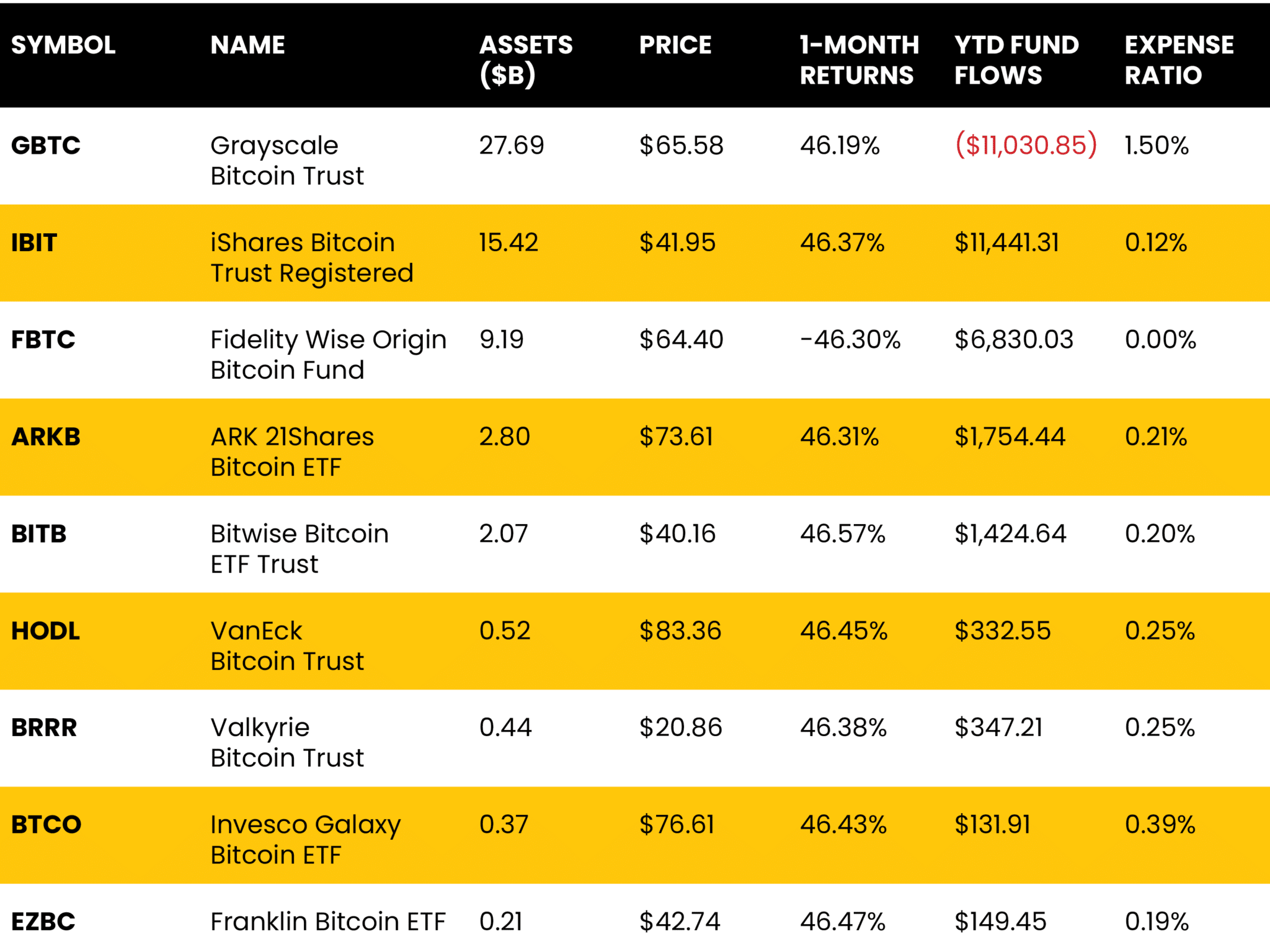Eight years after the first application for a “spot bitcoin ETF” was filed with the U.S. Securities and Exchange Commission, 10 of them started trading on Jan, 11, 2024. The landmark decision was precipitated by Grayscale’s legal victory against the SEC in 2023.
Sponsors of the nine so-called ETFs include well-known firms like Ark (with partner 21 Shares), BlackRock, Fidelity, Franklin Templeton, Invesco, VanEck and Wisdom Tree. These firms and others have either waived or reduced their fees in the first few months in a race to gather assets.
As of March 14, after roughly two months, this table shows how the asset gathering race has gone along with the differences in expense ratios and one-month returns.

At first glance GBTC from Grayscale, the company whose lawsuit paved the way for spot bitcoin ETFs, would seem to be the early winner with $28 billion in assets under management (AUM). That is nearly double the $15 billion in IBIT from iShares, in second place. However, it is the year-to-date fund flow numbers that tell the tale.
GBTC had been “the only game in town” prior to January 11. The complex trust share-issuance structure that Grayscale used was a more-expensive workaround to bring bitcoin to market prior to “spot bitcoin ETF” approval. Actually, its $28 billion represents a $11 million decrease in AUM, most of which have gone to less expensive competitors.
Since the new products were launched, iShares and Fidelity are dominating the asset gathering race. They also offer the lowest fees, albeit in both cases fee-waivers-since-inception have played into the mix. With 46% one-month returns and lots of hullaballoo, this has been the fastest growing category of ETFs in 2024.
But Are These ‘Spot Bitcoin ETFs’ Actually ETFs?
From a legal structural perspective, they are not. True exchange-traded funds (ETFs) are mutual funds. They are governed by the Investment Company Act of 1940. The individual shares of the fund are bought and sold on securities exchanges exactly as any other stock shares.
However, new fund shares are only created and redeemed through authorized participants in very large quantities — generally, more than $25,000 per transaction. These participants buy hundreds of fund shares at a time by contributing in-kind securities requested by the fund. They can be thought of as miniature replicas of the fund’s constituents, in the proportion held by the fund. To sell fund shares back to the fund itself, participants send the requested amount of fund shares per basket to the fund and receive baskets of the underlying securities in return.
This complex-sounding redemption process, now done routinely every day, is considered a free-receipt-and-delivery process. Unlike selling securities for cash, the free-receipt-and-delivery process is not subject to capital gains tax.
Advantages to the ETF Structure for Actual ETFs
The most obvious difference between the traditional redeem-at-the-distributor model of mutual fund and an ETF is that ETF shares can be bought, sold, etc., on the exchange and through a brokerage account just like any other stock. However, that difference is just the tip of the iceberg in terms of the new structure’s advantages over the old one. Here are some other advantages to the ETF investor and for some of the fund companies providing ETFs.
Improved flexibility
When shares are redeemed, the fund’s underlying securities – not cash – are transferred to the redeemer. This is called an in-kind redemption. Unlike selling securities on an exchange, an in-kind redemption is not considered a sale and thus does not realize any capital gains. This is what is meant by ETF tax efficiency.
Cost savings
Since shares are not redeemed for cash at the distributor, very little cash needs to be kept on hand for redemptions. This eliminates “cash drag” — having assets in cash that could be in stocks, at a time when stocks earn more than cash. Stocks earned more than cash in more than 80% of the years recorded since 1901. Therefore, cash drag generally hurts investor returns.
Return improvement
A corollary to this cash-drag fact is often overlooked. When investors invested in traditional structures redeem a large number of shares, mutual funds must sell stocks to raise cash. To mitigate capital gains, stocks with the highest capital gains are usually not sold in favor of stocks will lower amounts of capital gains. This often results in a fund liquidating newer positions while retaining older positions. It’s particularly problematic when actively managed funds use the old structure as you certainly want the newest investment ideas, not the stalest, from your active fund manager. No wonder one of the biggest industry trends in the past three years has been traditional active fund managers launching ETFs — after 20 years of warning about their dangers.
Potential return improvement
Instead of arcane forward pricing at net asset value (NAV), shares are bought and sold immediately on the exchange. This means traders know their costs and can fix their risk at a specific price at the time trade is submitted. If the market seems to be beginning a selloff at 10 a.m., shareholders have the ability to sell then instead of waiting for what could be a much greater fall at 4 p.m. Very few people would agree to buy or sell a car at a price to be determined at the end of the day. Why should mutual fund investors do so?
Price risk-management improvement
Another benefit to mutual fund companies is cost savings. ETFs have simplified transfer agency operations because the beneficial owners are the relatively small number of authorized participants dealing directly with the fund. All other shareholders are handled through their brokerage accounts and are not direct customers of the ETF.
Efficiency and Cost Savings Improvements
All of the above is discussed in my published paper “Leveling the Playing Field for Active Managers” available on the ValuEngine site.
The ETF Structure vs. The ‘ETF Wrapper’
Another term the investment industry and financial media use to describe launches is the “ETF wrapper.” A wrapper has no standing in investment law or with the SEC. It is old mutual fund jargon about different classes of fund shares offered to differentiated types of investors (e.g., 401(k) plan, high new worth, etc.). Since all types of investors have equal access to buy and sell ETF shares at the same price and fees and tax treatments, the word “wrapper” shouldn’t really apply. Moreover, I believe it demeans the actual structural advantages of the exchange-traded fund.
It probably should have been nicknamed ETMF in the beginning. However, ETF” was deemed by marketing experts at pioneering firms to sound catchier than ETMF.
At any rate, “experts” describe mutual funds now structured as ETFs as “being in the ETF wrapper.” Unfortunately, they also describe many other products as ETFs with the justification that “they use the ETF wrapper.”
Using ETF to describe something not associated with a mutual fund is not a new sleight-of-tongue. Experts have done it for years over the objections of sticklers like me.
The trend started with GLD, a depository receipt on physical gold, launched by State Street Global Advisors in cooperation with the World Gold Council in 2003. The structure was modeled after an ADR using the legal vehicle of a special type of trust called a grantor trust. A share of GLD is a share of a trust that can hold precious metals, foreign stocks, land deeds and many other things. The shares trade on stock exchanges. Upon sales, investors are taxed as if they had sold a pro rata portion of the underlying. Thus, they do not have the tax advantages of ETFs but a different tax treatment altogether.
This watershed event explains how products reflecting non-traditional-assets-with-financial-value that use the grantor trust and similar structures are now commonly called ETFs despite the fact that there is no actual fund associated with the product. Other products called ETFs with no fund include:
- Other exchange-traded metals such as SLV (silver), also a grantor trust.
- Exchange-traded commodity pools such as USO for oil and UNG for natural gas.
- Exchange-traded notes such as AMJ, JPM Alerian MLP;
- Closed-end funds – Regulated by the SEC as registered securities under the Securities Act of 1933.
- Offshore-incorporated funds holding derivatives and swaps such as BITO, ProShares Bitcoin Strategy Fund;
- Now, exchange-traded bitcoin, IBIT and nine others – using the same grantor trust structure as
a significant way that “bitcoin ETFs” differ from Precious Metals ETFs pertains to custody.
GLD is basically a depository receipt on a bank vault that contains gold. The gold is in a vault held by a major bank custodian such as BNY Mellon or JP Morgan Chase. Spot bitcoin ETFs are backed by bitcoin custodied in blockchain by independent non-banking institutions. The majority of spot bitcoin ETF issuers enlist Coinbase Custody Trust Company to store and manage their underlying bitcoin holdings. This list includes Ark 21Shares, Bitwise, Franklin, Grayscale and iShares. Taking distinctly different approaches, the VanEck Bitcoin Trust is backed by Gemini Custody and Valkyrie by Xapo Bank, while Fidelity opted for a self-custody option.
It can be argued that the blockchain technology that essentially takes the place of bank vaults is so sophisticated and impenetrable that it is safer than bank vaults. Only time will tell. However, if it comes down to the financial assets of the custodian as a counterparty, one should be aware that neither Coinbase nor Xapo Bank are investment-grade debt issuers according to either Moody’s or Standard and Poor’s.
Warning: Tax Treatments May Vary
Tax treatments are another very important reason to make a distinction between ETFs, gtrantor trusts, commodity pools, structured notes, managed futures products, funds incorporated offshore and other products. For the first example, let’s take GLD which, as mentioned above, is a grantor trust.
A grantor trust is ignored for tax purposes so that the investor is treated as owning a pro-rata share of the underlying holdings, not the entity. If GLD were a mutual fund, it would be taxed “normally,” but because it is a grantor trust, its long-term gains are taxed as a collectibles gain – at the 28% rate.
One positive aspect to GLD, SLV and other precious-metals ETFs that do not use futures to generate income is that they do not issue K-1 forms (which business partnerships use to report to the IRS a partner’s income, losses, capital gains, dividends, etc. from the partnership for the year). Many tax-filers intensely dislike receiving K-1 filings, First, figures from the form must often be integrated into a regular tax return. Companies are also inconsistent about when they send K-1 forms to their investors, which can cause delays in filing tax returns.
At least 36 commodity “ETFs” that are actually shares of ownership in a commodity-pool partnership issue K-1 forms. So do a number of currency funds and alternative investments that use futures to enhance returns and/or income. Some offshore companies that issue exchange-traded shares also issue K-1 forms. Exchange-traded notes such as AMJ do not need to issue K-1s but they do carry counterparty risk.
So, What Does this Portend for the New ‘Bitcoin ETFs?’
One interpretation is that capital gains will be taxed as ordinary capital gains as is the case of currency ETFs. The IRS thus far has said that the entire area is still under study. In general, the IRS treats cryptocurrencies as property, impacting tax implications for gains and losses.
If they are taxed similar to currency ETFs, holding bitcoin ETFs for over a year may result in lower long-term capital-gains tax rates, offering potential tax advantages.
Strict adherence to IRS rules, including comprehensive reporting of cryptocurrency transactions, is vital for tax compliance. The global tax authorities, in addition to investors, have taken a keen interest in cryptocurrencies. For instance, the IRS has aggressively attempted to create and implement cryptocurrency-related tax laws.
Therefore, anyone investing in digital currencies like bitcoin (BTC) must comprehend how the IRs views taxes on cryptocurrency profits and bitcoin ETFs. Investors must also be aware that a significant portion of this equation has yet to be determined.
Again, this column does not attempt to give — nor is it competent to give — tax advice. It’s designed for educational purposes to raise awareness that all things referred to as ETFs are not actual exchange-traded funds. Just because the media or a broker calls something an ETF, this does not mean it provides the tax and operational efficiencies associated with U.S. equity ETFs.
It always pays to read the prospectus and do your own homework when making investments in general. When it comes to products “in the ETF wrapper,” encourage your client to speak to you or a tax specialist before uying or selling these instruments.
Herb Blank is a senior quantitative analyst at ValuEngine and senior consultant and practice leader in the Global Finesse Product Strategy and Implementations Consulting Practice. He has more than 30 years of experience in financial product innovation and quantitative analysis. Recognized as a pioneer in the exchange-traded fund (ETF) industry, Blank established the first family of ETFs to trade on the NYSE and was a portfolio manager for the fund. He is credited with the product development and launch of iShares, GLD and X Shares. He is also well known for developing construction and maintenance methodologies for Dow Jones Global Indexes.







